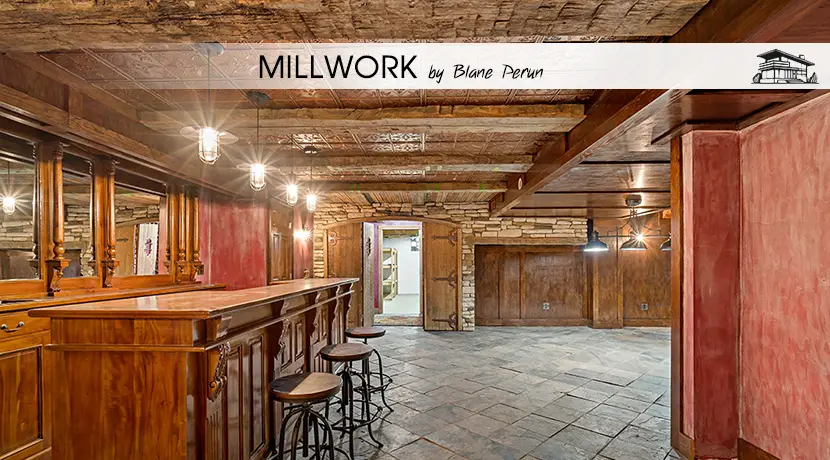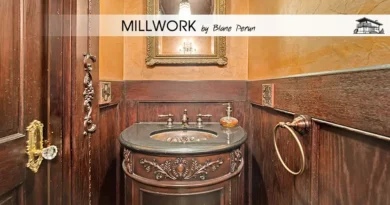Moulding and Millwork
Elevating Your Space: A Deep Dive into Moulding and Millwork
When it comes to enhancing the aesthetic appeal and value of your interiors, few elements play a role as pivotal as moulding and millwork. These architectural embellishments are more than just decorative trims; they embody the artistry and craftsmanship that have been hallmarks of sophisticated architecture for centuries. From the ornate crown mouldings gracing the ceilings of historic mansions to the sleek and modern baseboards in contemporary homes, moulding and millwork are integral to creating character and depth in any space.

Understanding the Basics: Moulding and Millwork Fundamentals
The Art of Architectural Moulding
Architectural moulding, a key component of millwork, involves the creation of intricate trim pieces designed to add elegance and detail to the structural elements of a building. This includes baseboards, crown mouldings, casings, and more. These pieces not only serve to cover transitions between different surfaces but also add a layer of sophistication and finish to the overall design.
Millwork: Crafting Beauty and Function
Millwork, on the other hand, encompasses a broader range of woodwork products, including doors, window casings, and mantels, among others. Unlike moulding, which is often purely decorative, millwork can also include functional elements designed to enhance the usability and efficiency of a space. The craftsmanship involved in creating millwork pieces combines technical skill with artistic flair, resulting in elements that are both beautiful and purposeful.
Trends and Innovations: Keeping Up with Moulding and Millwork
Eco-Friendly Materials in Moulding
Sustainability has become a significant concern in all aspects of design, including moulding and millwork. Manufacturers and designers are increasingly turning to eco-friendly materials, such as reclaimed wood and rapidly renewable resources, to create mouldings that are not only aesthetically pleasing but also environmentally responsible. This shift towards green materials reflects a broader trend in the industry towards sustainability and conservation.
Technological Advancements in Millwork Design
The integration of technology into the design and manufacturing of millwork has opened up new possibilities for customization and precision. Computer-aided design (CAD) and computer numerical control (CNC) machines allow for the creation of intricate patterns and shapes that would be difficult, if not impossible, to achieve by hand. This technological leap has made it possible to create unique and complex millwork pieces that can be tailored to the specific needs and preferences of each client.
Practical Applications: Moulding and Millwork in Modern Spaces
Moulding as a Design Element
In contemporary design, moulding is often used as a tool to define and enhance the architectural elements of a space. Whether it’s through the subtle addition of a chair rail to delineate spaces or the dramatic impact of an ornate crown moulding, these elements can significantly alter the perception and feel of an area. Moulding can also be used to create visual interest and contrast, adding layers of texture and depth to otherwise flat surfaces.
Incorporating Millwork for Functionality and Style
Millwork goes beyond mere decoration to provide functional elements that are integral to the structure and design of a space. From built-in shelving that maximizes storage to custom cabinetry that fits seamlessly into the kitchen’s layout, millwork can be both practical and beautiful. The ability to customize these elements allows for a level of personalization and efficiency that is highly valued in modern design.
In the realm of interior design and architecture, the roles of moulding and millwork cannot be overstated. These elements, while often subtle, contribute significantly to the character and ambiance of a space. Whether it’s through the classic elegance of traditional mouldings or the clean lines of modern millwork, these architectural details offer a canvas for creativity and personal expression.

FAQs on Moulding and Millwork
What is the difference between moulding and millwork? Moulding typically refers to the decorative trim used to accentuate and frame various architectural features, such as walls, ceilings, and doors. Millwork, however, encompasses a broader range of wooden building products, including doors, window casings, and cabinetry. While moulding is often primarily decorative, millwork can include both decorative and functional elements.
How can moulding and millwork impact the overall design of a room? Moulding and millwork can significantly enhance the aesthetic appeal and perceived value of a room by adding depth, character, and sophistication. These elements can highlight architectural features, create visual interest, and help define the style and tone of a space. Additionally, they can be used to hide imperfections and transitions between different materials.
Are there sustainable options for moulding and millwork? Yes, the industry has seen a growing trend towards sustainability, with many manufacturers offering moulding and millwork made from eco-friendly materials. This includes products made from reclaimed wood, rapidly renewable resources, and materials with low environmental impact. These sustainable options allow homeowners and designers to choose aesthetically pleasing designs without compromising their environmental values.
Can moulding and millwork be customized for specific design needs? Absolutely. One of the significant advantages of moulding and millwork is their versatility and adaptability to various design requirements. With advancements in technology, such as CAD (Computer-Aided Design) and CNC (Computer Numerical Control) machining, it’s possible to create custom designs that fit the exact specifications and aesthetic preferences of a project. This level of customization enables designers and homeowners to achieve a unique look that reflects their personal style and complements the overall design of their space.
How do I choose the right moulding and millwork for my home? Choosing the right moulding and millwork involves considering several factors, including the architectural style of your home, the desired aesthetic effect, and the functionality of the space. It’s essential to look at the scale of the moulding in relation to the room size and ceiling height, as well as the material and finish that will best complement the existing décor. Consulting with a design professional can provide valuable insights and help you make informed decisions that enhance the beauty and functionality of your home.
In conclusion, moulding and millwork are not just decorative additions but fundamental components that contribute significantly to the character and refinement of a space. Whether you’re embarking on a new construction project or looking to revamp an existing space, incorporating thoughtfully chosen moulding and millwork can elevate your design from ordinary to extraordinary. As we continue to embrace both the heritage and innovation within the realm of moulding and millwork, these elements remain at the heart of creating spaces that are not only beautiful but also resonate with the personal tastes and lifestyles of those who inhabit them.





